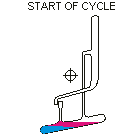BATCH AND CONTINOUS EXTRACTION
For a long time, the food industry has relied on a large-scale continuous process. At the outset, the production facilities for new products used to be a batch process produced on a larger scale because of reduced investment costs. As the economy of scale has become a main factor, food process industries and process engineering, in general, emphasized on developing and designing continuous processes for mass production of goods.
However, specialty products and product diversification, with more emphasis on customer requirements and their need for food security and high quality, as well as trace ability requirements, mean that equal focus has shifted to batch processes. In fact, almost half of today’s processes in the food industry are actually batch processes.
Industrial processes can actually be classified based on the process’ output as:
- Batch processes
- Continuous processes
So, what are these two and how are they different from one another?
Batch Process
Batch process refers to a process that consists of a sequence of one or more steps that should be performed in a defined order. A finite quantity of the product is produced at the end of the sequence, which is repeated in order to produce another product batch.
Generally, batch is a process that results in the production of limited quantities of material through subjecting quantities of raw materials to a set of processing activities over a significant period of time with the use of one of more piece of equipment. Processing of successive batches must wait until the completion of the current batch.
Continuous Process
A continuous process, on the other hand, refers to a processing that involves moving a single work unit at a time between every step of the process without any breaks in time, substance, sequence or extend. As the name suggests, the flow of product or material is continuous. Every machine operates in a steady state and performs a certain processing function.
For majority of applications, continuous flow saves costs, energy and time. When this process is properly implemented, it can reduce waste, improve quality by making it easier to identify and correct errors, increase productivity and adapt to the needs of customers more efficiently than batch processing.
Comparing the Processes
Evaluating the advantage and disadvantages of every type of process is important to determine which one would work best for you.
When it comes to the cost of equipment, continuous process is more expensive than the low process. However, when comparing the production rate, continuous have lower rate than the continuous one. The shut-down times in continuous process is rare, whereas it happens quite more often in a batch process.
If you don’t have enough manpower to perform the work, you can benefit more with a continuous process, as it requires a fewer people than its counterpart. In terms of ease of automation, batch process is relatively more difficult than the continuous process.
Both continuous and batch processes are vital in the production of materials or products. Having a deeper understanding of each of them can help you make an informed decision in the end.
| Batch Process | Continuous Process | |
|---|---|---|
| Definition | Batch process refers to a process that involves a sequence of steps followed in a specific order. | Continuous process refers to the flow of a single unit of product between every step of the process without any break in time, substance or extend. |
| Coordination | Scheduling is done to maintain the timing between move to earth. | Each machine performs a certain processing function and they operates in a steady state. |
| Quantities produced | A whole unit of products are produced. | Large quantities of products are obtained. |
| Fouling | Batch process is involved if the fouling expectations are high | Continuous process is involved if fouling is not considered |
| Product life span | Short, 1-2 years | Longer than batch process |
| Cost of factory equipment | Low cost equipment | High cost equipment |
| Controlling | Batch process can be controlled very easily | Control batch process requires sophisticated control systems |
| Shut Down times | Often | Rare |
| Workforce | Small workforce is needed | Continuous process is generally available in fully automated plants. If not, large workforce will be necessary. |
Similar extractors for laboratory-scale liquidliquid extraction, again shown in Figure 2, are also based on distilling the extracting solvent with subsequent condensation. The condensed solvent passes though the sample solution to be extracted, phase separation occurs, and the extracting solvent flows back into the receiving flask for redistillation. Design considerations account for the solvent density. The glassware shown in Figure 2B is representative of aqueous-organic extractions using heavier-than-water solvents, while Figure 2C illustrates an apparatus for use with lighter-than-water solvents.

Laboratory glassware for performing (A) Soxhlet extraction, (B) liquid-liquid extraction with extracting solvents more dense than the liquid solvent, and (C) liquid-liquid extraction with extracting solvents less dense than the liquid sample.

Comments
Post a Comment